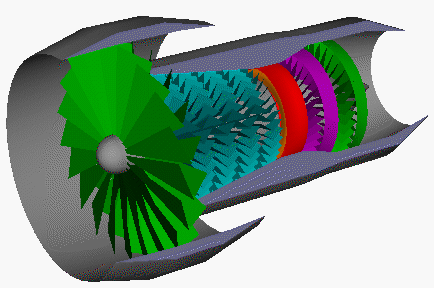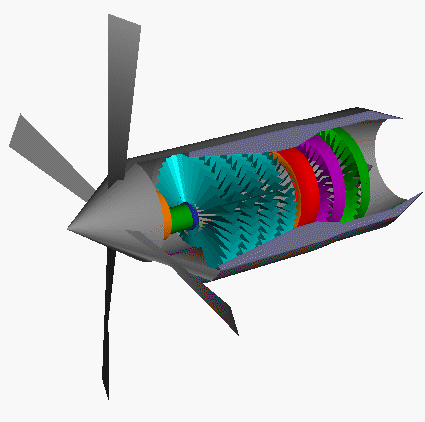Types Of Jet Engines
Turbofan Engine

To move an airplane through the air, thrust is generated by some kind of propulsion system. Most modern airliners use turbofan engines because of their high thrust and good fuel efficiency. On this page, we will discuss some of the fundamentals of turbofan engines.
A turbofan engine is the most modern variation of the basic gas turbine engine. As with other gas turbines, there is a core engine, whose parts and operation are discussed on a separate page. In the turbofan engine, the core engine is surrounded by a fan in the front and an additional turbine at the rear. The fan and fan turbine are composed of many blades, like the core compressor and core turbine, and are connected to an additional shaft. All of this additional turbomachinery is colored green on the schematic. As with the core compressor and turbine, some of the fan blades turn with the shaft and some blades remain stationary. The fan shaft passes through the core shaft for mechanical reasons. This type of arrangement is called a two spool engine (one "spool" for the fan, one "spool" for the core.) Some advanced engines have additional spools for even higher efficiency.
How does a turbofan engine work? The incoming air is captured by the engine inlet. Some of the incoming air passes through the fan and continues on into the core compressor and then the burner, where it is mixed with fuel and combustion occurs. The hot exhaust passes through the core and fan turbines and then out the nozzle, as in a basic turbojet. The rest of the incoming air passes through the fan and bypasses, or goes around the engine, just like the air through a propeller. The air that goes through the fan has a velocity that is slightly increased from free stream. So a turbofan gets some of its thrust from the core and some of its thrust from the fan. The ratio of the air that goes around the engine to the air that goes through the core is called the bypass ratio.
Because the fuel flow rate for the core is changed only a small amount by the addition of the fan, a turbofan generates more thrust for nearly the same amount of fuel used by the core. This means that a turbofan is very fuel efficient. In fact, high bypass ratio turbofans are nearly as fuel efficient as turboprops. Because the fan is enclosed by the inlet and is composed of many blades, it can operate efficiently at higher speeds than a simple propeller. That is why turbofans are found on high speed transports and propellers are used on low speed transports. Low bypass ratio turbofans are still more fuel efficient than basic turbojets. Many modern fighter planes actually use low bypass ratio turbofans equipped with afterburners. They can then cruise efficiently but still have high thrust when dogfighting. Even though the fighter plane can fly much faster than the speed of sound, the air going into the engine must travel less than the speed of sound for high efficiency. Therefore, the airplane inlet slows the air down from supersonic speeds.
TURBOPROP Jet Engine:

Many low speed transport aircraft and small commuter aircraft use turboprop propulsion.This page shows some of the fundamentals of turboprop engines. The turboprop uses a gas turbine core to turn a propeller. As mentioned on a previous page, propeller engines develop thrust by moving a large mass of air through a small change in velocity. Propellers are very efficient and can use nearly any kind of engine to turn the prop (including humans!). In the turboprop, a gas turbine core is used. How does a turboprop engine work?
There are two main parts to a turboprop propulsion system, the core engine and the propeller. The core is very similar to a basic turbojet except that instead of expanding all the hot exhaust through the nozzle to produce thrust, most of the energy of the exhaust is used to turn the turbine. There may be an additional turbine stage present, as shown in green on the diagram, which is connected to a drive shaft. The drive shaft, also shown in green, is connected to a gear box. The gear box is then connected to a propeller that produces most of the thrust. The exhaust velocity of a turboprop is low and contributes little thrust because most of the energy of the core exhaust has gone into turning the drive shaft.
Because propellers become less efficient as the speed of the aircraft increases, turboprops are used only for low speed aircraft like cargo planes. High speed transports usually use high bypass turbofans because of the high fuel efficiency and high speed capability of turbofans. A variation of the turboprop engine is the turboshaft engine. In a turboshaft engine, the gear box is not connected to a propeller but to some other drive device. Turboshaft engines are used in many helicopters, as well as tanks, boats, and even race cars in the late 1960's.
Turbojet Engine
The turbojet is the basic engine of the jet age. Air is drawn into the engine through the front intake. The compressor squeezes the air to many times normal atmospheric pressure and forces it into the combustor. Here, fuel is sprayed into the compressed air, is ignited and burned continuously like a blowtorch. The burning gases expand rapidly rearward and pass through the turbine. The turbine extracts energy from the expanding gases to drive the compressor, which intakes more air. After leaving the turbine, the hot gases exit at the rear of the engine, giving the aircraft its forward push ... action, reaction !
For additional thrust or power, an afterburner or augmentor can be added. Additional fuel is introduced into the hot exhaust and burned with a resultant increase of up to 50 percent in engine thrust by way of even higher velocity and more push.

